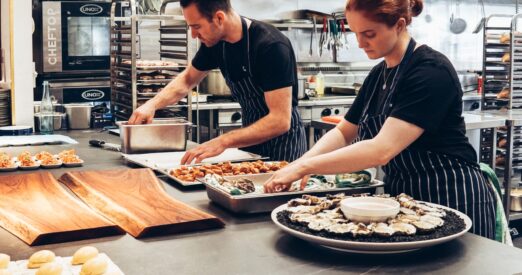
Vendors for Restaurants: Unlocking Better Pricing Strategies
by The Ottimate Editorial Team
Vendors for restaurants are essential to your business. Just as important as ingredients are to a recipe, the relationship between suppliers and the purchaser is an important aspect of efficient, predictable restaurant operations.
But keeping that relationship in good standing, at times, is difficult.
Food costs fluctuate more than almost any other inputs a business has to deal with. And unlike other volatile inputs, like fuel, food is not a commodity. One supplier’s product is not necessarily equal to that of another supplier. In truth, the quality of a single product with the same vendor might vary on a given day (high-quality orders of fish, for example). It all combines for a confusing, time-consuming area of oversight.

In a worst case scenario, food cost fluctuations might mean that your menu price is out of sync with the ingredient costs, which would then obliterate your margins.
A restaurant putting out a quality product sustainably needs to manage both the cost and the quality of their food orders. And the key to that is engaged vendors.
Wait — I Want Happy Vendors, Right?
Happy vendors are great. They’re confident that they’ll get their money on time, they like you as a customer, they’re not talking about you negatively to the other vendors. Fantastic, right?
But happy vendors for restaurants might also be ones that are too comfortable with your relationship. On a day when a vendor needs to figure out who gets delivery of the prime produce or fish, that vendor is going to make sure it goes to you?
Maybe. Or maybe they’ll designate it for that other restaurant who, sometimes, can be a bit of a squeaky wheel.
Ultimately, happy vendors are not as valuable as vendors that are engaged. Vendors who view you as a reliable customer, yes, and with whom you have a good professional relationship — but who also think of you as someone who demands quality goods and service.
Developing an engaging relationship with your vendors isn’t complicated. More than anything, it’s about showing up and paying attention. Here’s how to do this in your own restaurant.

Pay on Time — But Not Too Early
Step one of any good vendor relationship starts with making sure you always pay on time. That way, when the vendor sees your name on a list of deliveries for that day, they’ll know they’re dealing with someone they can trust.
But unless you have to, for reasons particular to your business, it’s not advisable to pay cash-on-the-barrelhead. Having payments ready on delivery is not necessarily what makes a vendor view you as a responsible partner. If anything, they might view you as someone who doesn’t trust themselves to adhere to terms.
Instead, aim to consistently pay what the terms stipulate. If a purchase is net 30, try to have your payment arrive after day 20. If the terms are 2% 10 net 30 — a 2% early payment discount within 10 days, and otherwise net 30 — pay on day nine or 10.
The reason is simple: paying on terms is better for your business and the vendor knows that. Showing that you are able to consistently thread the needle of on-time payments that work to your benefit will be something that screams competent cash flow management. It’s the kind of thing that makes a vendor view your business as a well-run operation worthy of top-level service that they’re always happy to extend.
Interested in scheduling payments ahead of time in a simple way? Check out Ottimate’s VendorPay today.
Show That You’re Paying Attention to Prices of Vendors for Restaurants
Vendors and restaurants have the naturally adversarial relationship that occurs between any buyer and seller. They want prices high, you want them low. Nothing wrong with that. It makes the world go round.
But given the nature of this relationship, it’s important to demonstrate to vendors that you’re on top of what’s going on around you. Show that you’re keeping a close watch over your business, and that you’re informed about the relationship you have with them.
Another way to put it is, if you want your vendors to be engaged, lead by showing that you’re engaged first.
Suppose you have a contracted price agreement in place for a given food item. Now suppose the vendor happens to ease the price beyond what you agreed upon — but still within a limit that you feel is reasonable, based on what you know about the market and the relationship the two of you have. Does this warrant action on your part?
It sure does. A friendly call or email to your vendor, making note of or inquiring about the price increase, shows them you’re watching your purchases carefully — and that you’re armed with tools that will help you see other price increases in the future.
Check out Ottimate’s features if you’re interested in learning more about these tools.
The same principle applies to prices across locations.
If the same supplier is selling one of your stores french fries for 10% less than they’re charging to another location elsewhere, it’s a good idea to find out more. Maybe they don’t even know it’s happening. But what’s for sure is that they know you will.
Lastly, keep tabs on the quality of the products being delivered to you. Not all shipments of lettuce or cuts of meat are the same. Let the delivery driver see that you’re interested in what you’re getting from them and that you’re engaged. This, in turn, will engage them in the project of keeping you a happy customer.
Maintain Relationships With Everyone on Your Vendor’s Team
While demonstrating your attentiveness and operational skill (both of which become much easier to prove with AP automation), it’s also important to have a relationship with your vendor, from top to bottom.
Get to know your sales rep. Form a collegial relationship so that they trust you and you trust them. When they call, make time to answer. Be generous with the observations you’re gathering from the front lines of the market, and about your business. That’s an important part of what they trade in, so help them out where possible.

See if you can get to know the owners of your supply companies. Help them see you vividly as fellow entrepreneurs, not just another faceless customer. Take an interest in the marketing they do about their local sources, farmers, producers — vendors love to promote these relationships and will appreciate it paying off with you. Of course, it’s always invaluable to know where your food is actually coming from.
Finally, be friendly to your delivery drivers. These are the people you’ll encounter face-to-face most often, so treat them like valued customers. If there’s a certain menu item you know they like, see if you can have one ready for them. Be polite in any situation when you need to send back orders or ask questions about what they’ve just delivered.
Above all, put a positive human face on the business they’re transacting with. Life and business get easier when you have happy relationships between you and your counterparties.
Establish a Diverse Base of Vendors for Restaurants
No one vendor or small group of vendor for restaurants should ever be your sole lifeline to quality products — or to market insights. To keep your purchasing stable and your vendors engaged, purchase from a number of them.
Maintaining good relationships with multiple vendors helps keep your prices stable. Knowing what different suppliers charge for similar goods exerts downward pressure on your costs by empowering you to negotiate for better prices.
Plus, when a vendor knows that one of their customers is plugged into the market as an active and intelligent participant, they will be more likely to offer you favorable terms. Having established your ability to manage cash flow with on-time payments, it’ll be a no-brainer.
How To Make All This Easy
Some of these tactics you’re probably already applying. Some you may be wary of. In reality, all are quite accessible with the right tools in place.
Monitoring price increases is time-consuming and annoying — unless you have automation in place that runs in the background, flagging anything that it notices.
Keeping pricing consistent across locations is traditionally a manual task far down on any busy restaurateur’s to-do list — unless you have automation in place that does it for you.
Most important, sending payments on time is easy with bill pay automation. Ottimate’s VendorPay, for example, gives you a calendar view that lets you select exactly when you want to send payments. All your AP team needs to do is schedule a payment.

Plus, with digital payments like ACH and virtual cards — the latter of which earns cashback on your spend — you can even solve for the growing issue of USPS delays in your vendor payments.
All of these tactics lead to more engaged vendors for restaurants and a smoother operation for your business. Your customers — and maybe the delivery guy — will thank you.
To learn how Ottimate VendorPay can help your restaurant maintain great vendor relationships, request a demo today.
Stay up to date on the latest news in AP automation and finance
Related

